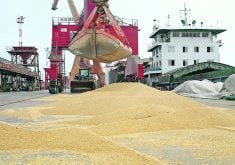UPDATED: December 19, 2024 – 1020 CST – Glacier FarmMedia – The 2024 fall economic statement shows Canada has a $61.9 billion deficit and makes few mentions of agriculture.
The statement was released Monday afternoon after a chaotic day which saw Finance Minister Chrystia Freeland resigning from her post hours before presenting the document.
The 2024 budget predicted Canada to have $40 billion deficit for 2024. That number has increased by $21.8 billion, according to the fall economic statement.
Read Also

Gap in emission regulations hamstrings Canadian hybrid truck manufacturer
A B.C. company building hybrid engines for heavy trucks says they have the opportunity to build something leading edge in Canada, but our own laws are stopping them from doing it.
There are only a few mentions of farming and agriculture in the 270-page document, including a proposal of $4.3 million to the Canadian Food Inspection Agency over three years. An investment in biofuel production will also provide a boost to the agriculture sector, the statement reads.
Agriculture is also given a mention in the section Leveraging AI to Boost Public Service Productivity, as Agriculture and Agri-Food Canada (AAFC) is using a chatbot to inform farmers on available services.
The federal government is predicting a deficit of $48.3 billion, or 1.6 per cent of GDP, in 2024-25.
The economic scenario analysis portion of the statement examines several uncertainties in Canada’s future, including the impacts of the incoming U.S. administration.
The statement’s “downside scenario,” the less optimistic of two alternative economic scenarios presented in the document, sees growth stall and the labour market continue to weaken. This scenario would lead lower consumption and demand, the statement said.
In this scenario, the federal budgetary balance would deteriorate by an average of approximately $6 billion per year, and add 1.3 percentage points to the federal-debt-to-GDP ratio in 2029-30 compared to the same year of the economic statement.
In the statement’s “upside scenario,” Canada sees supply improvements and a reversal of GDP per capital decline. This could translate into higher commodity costs, benefiting Canadian producers. The budgetary balance would improve by an average of approximately $9.2 billion per year, and the federal debt-to-GDP ratio would end up 1.6 percentage points lower than the 2024 Fall Economic Statement’s forecast for 2029-30.
However, “Given the importance of trade to the Canadian economy, the uncertainty surrounding North American and global trade policies suggests that the balance of risks to growth are tilted to the downside,” the statement said.
















